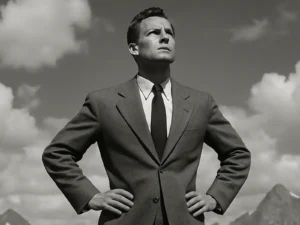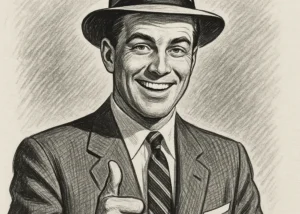The idea of ethnographic futures has been at the forefront of my mind in recent weeks. After reading a number of papers and a book on Design Ethnography (Pink et al.) I have come to realise just how much work I’ve already done in this field. Today, I have been pouring over papers for an ethnographic workshop later in the week with Deakin Uni. When I was asked earlier this week for examples, I suddenly realised how many I had organised and run—less the anthropological lens.
On reflection, design, advertising, and marketing are inherently future-focused. One of my long-standing issues with marketing data is that it’s always retrospective—a record of what was rather than what could be. It consists of artefacts of predicted futures. Looking back, the early days of the 1950s and marketing technology did an exceptional job—albeit often sexist—of selling the future. In doing so, they cultivated an atmosphere of imagined futures.
Let’s take a step back. Advertising agencies are wild places. They require energy, open-mindedness, and an unburdened imagination to explore future possibilities truly. A client submits a brief aiming to meet a particular goal. The first task is to understand the target audience and align the business’s objectives with the audience’s—finding the communication or idea that connects the two. This, in itself, is a topic worthy of a research paper. We used many methods to understand audiences. Sometimes, we mined client databases. Other times, we accessed large datasets like Roy Morgan Single Source. Again artefacts (Cenus data quickly outdates). But my favourite projects were immersive ones, where account managers, media strategists, and creative directors got to know the audience firsthand.
I remember one project at an international agency where we transformed the boardroom into a giant children’s bedroom—oversized toys, chairs, a bed, and beanbags. The client was initially brought in for workshops, discussing why they developed their products and how they imagined children engaging with them. We made them show us. As the sessions continued (and as a few bottles of Shiraz were consumed), the atmosphere became more relaxed and creative. In the following days, parents and teenagers were invited to play. The main takeaway was that, regardless of age, imagination was a key determining factor—especially when inspired. From that, a “Make It Your Own” campaign was developed, which became a commercial success.
On a smaller scale, more recently, I worked on a campaign for a paper company—one of my favourites because it resulted in stock selling out quickly. Over the years, I’ve run countless campaigns involving giveaways or prizes. Surprisingly, the hardest is the million-dollar giveaway. People are likelier to enter a competition with multiple smaller prizes than one colossal prize. I’ll return to this point. The challenge for the paper company was selling a particular quality of paper. We decided to conduct street interviews in Melbourne, filming 50 interviews over a few days. Each participant was asked permission to use their footage, and surprisingly, most signed the waiver. The key question: What would you do with a million dollars? The responses fell into three themes: fun (buying a cow was a classic), philanthropy, and self-indulgence. We grouped the responses and cut them into 60-second and shorter individual clips, then used them for targeted advertising—matching demographics and affinities to the three categories. The response exceeded expectations. The paper sold out within weeks, engagement rates were high, and the comments provided rich consumer insights for future campaigns. Who would have guessed that someone wanting to buy a cow would resonate powerfully with an audience?
Returning to the idea of multiple prizes versus a single large prize, this phenomenon has always fascinated me. My first experience with it was in the early 2000s when I ran a promotion to give away a $130,000 luxury car. The campaign offered alternative prizes like luxury holidays and experiences. It was a free entry competition by just watching a 60-second video and answer a simple question. Yet, the conversion rate was only 1%. Over 12 weeks, only a couple of thousand people entered. A few years later, I ran a campaign for a major sporting event, giving away tickets to the main event. The same low response happened again. Puzzled, I pushed the sporting body to study fan behaviour. Over the following months, we visited grassroots clubs, attended games, spoke to supporters, and even spent time in the bar. After visiting ten clubs, a clear pattern emerged: fans calculated the odds before entering. They assumed that thousands of people would join, making their chances slim. So, why bother? For the next event, we changed the approach—offering daily giveaways of single tickets with a secondary chance to win two tickets to the final. The impact was immediate. From memory, the result was a dramatic increase in entries, with over 100,000 participants.
Another campaign that stands out was for a travel company I had initially been dismissive of. Over a couple of weekends, we invited families and couples into the agency, interviewing them on camera about their ideal cruise holiday. After a few interviews, I realised the data we had been working with wasn’t thick enough for any meaningful planning. Each group received lunch and travel discounts for participating. Looking back, I’d now question the authenticity of their responses, but at the time, the videos inspired the client to adopt a new creative approach. Travel is an imagined event—it reveals both social and personal values and connections to everyday life. The messaging and image work was very ‘inspirational’ with amazing footage of destinations and motivating music. The idea was to inspired a future travel which was a success. However! Money wins out an the agency incouraged the client on to the next project.
This is just a quick reflection on over a hundred consumer group studies and research projects I’ve worked on. I’ll leave this opened ended to add some more case studies.
- home built in an office
- focus groups in a hardware store, also the inspiraton for my Scmackos ad “builders mate”
- hours in repco store watching men buy motor oil
- endless number of focus groups on everything from school snacks to colour selection for branding
- 50+ hours in display homes learning about how people imagined thier future home
- hours in aged care facilities speaking to families
- countless UX sessions/ Considering I have built over 400 websites, that is a lot of time
- owning a icecream and confectonary retail store was an endless study




